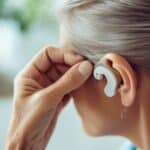The ICD-10 Puzzle: Deciphering Bilateral Tinnitus and Its Impact
- Get link
- X
- Other Apps
Introduction
Ever wondered why some auditory perceptions seem to come with a constant ringing sound from both ears, even in the absence of any sound in the surroundings? The ICD 10 Bilateral Tinnitus is a phenomenon that you might want to understand if this sounds familiar. But first, let’s provide a broader backdrop starting from the basics of Tinnitus.
What is Bilateral Tinnitus
The term “Bilateral Tinnitus” might sound like a couple of heavy medical terms organically squeezed into a phrase. However, when you dissect its components, it is nothing more than an amalgam of “bi,” which stands for two, and “lateral,” indicating a direction or site, combined with “Tinnitus,” which is an ongoing ringing or noise sensation in the ears. In essence, bilateral tinnitus is a form of tinnitus where a patient hears some noise sensation simultaneously in both his or her ears. It’s like having an uninvited internal symphony created between your ears, which can range from being mildly unsettling to severely disturbing. Popping on over to our blog on “What is Bilateral Tinnitus” will give you a more comprehensive understanding.
The causes vary – from exposure to loud sounds, which injures the ear cells, to age-related hearing loss, earwax blockage, or even certain medications. Essentially, any situation leading to a change in the ear’s circulation or nervous system can potentially cause tinnitus bilaterally.
Symptoms? Apart from the continuous ringing, hissing, or buzzing in both ears, they are largely similar to what you might expect from regular Tinnitus. That said, the nature of the sound can vary from person to person, with it being a constant tone for some to an intermittent series of sounds for others.
Understanding ICD 10 Bilateral Tinnitus
Ready for some more jargon? Welcome to ICD 10 Bilateral Tinnitus. ICD-10 is a system put in place by The World Health Organization and provides a code that corresponds to specific conditions, in this instance, Bilateral Tinnitus. In layman’s terms, you might consider it a keyword or tag for medical researchers and practitioners. The magic code here is H93.13. Wondering what this implies in the medical world? You might want to tune in to our related blog post about ICD 10 Bilateral Tinnitus.
This alphanumeric term is not just a piece of medical jargon. It plays a pivotal role in enabling effective and clear communication across different healthcare providers and settings. The use of H93.13 as a standard term facilitates the sharing of information across specialists, labs, hospitals, and other facilities in managing patient care.
So, the next time you come across the phrase ICD 10 Bilateral Tinnitus, remember it’s more than just a buzzword. It represents the world of healthcare constantly striving to bring uniformity and comprehensiveness into understanding and treating conditions, even if it’s an unending hum echoing through the corridors of your ears.
Differentiating Bilateral and Unilateral Tinnitus
Just as the names imply, bilateral and unilateral tinnitus refers to the sensation of noise in both ears and in one ear, respectively. It’s like having a radio playing a phantom broadcast in both headphones versus just one. Now, isn’t that something worth noting?
But here’s where it gets interesting. Just like identical twins with distinct personalities, these two forms of tinnitus, despite their similarities, have unique characteristics that define them. While the noise sensations in bilateral tinnitus might be symmetrical – think of two drummers maintaining a steady beat on each side of your head – unilateral tinnitus is more like a solo act, with one ear stealing the limelight with a solo performance.
Symptoms? Well, they are largely similar across both types, predominantly characterized by varying forms of sound phenomena that can range from a low roar to a high squeal. The sound can be intermittent or continuous, with varying volumes. To delve deeper into this comparison, our blog on “Unilateral and Bilateral Tinnitus” could provide further insights.
ICD 10 Codes for Tinnitus: A Comprehensive List
Let’s dive into the medical lexicon once again. Just like our discussion on the ICD 10 Code for Bilateral Tinnitus (H93.13), there are ICD 10 codes for different forms of Tinnitus. Consider these like tags given to different books in a library – efficient and effective!
For instance, if the tinnitus is only in one ear, we use the term Unilateral Tinnitus. And yes, you guessed it, they have their own ICD 10 codes too! Tinnitus in the right ear is coded as H93.11 and in the left ear as H93.12. You can explore more about these codes in our respective blog posts on “ICD 10 Code for Tinnitus” and “Tinnitus in One Ear”.
How Tinnitus is Diagnosed
Now, let’s get down to the brass tacks. How is Tinnitus diagnosed, and what’s the role of ICD 10 codes in that process? To start with, a diagnosis typically involves an audiometric (hearing) test, a physical examination, and a review of your health history. Sometimes more specialized tests are required.
However, having standardized codes makes it far easier to communicate a condition across diverse healthcare settings, for the management of patient care or conducting research. Like a universal language, these codes bridge the gap, allowing healthcare professionals to understand a condition in the most standardized, concise, and clear manner. Why, you might ask? Stop by our “ICD 10 Tinnitus” blog post for some more insights.
Remember, having a standardized system of codes not only aids in the management of patient care but also helps in making globally recognized research and reference systems more efficient.
Dealing with Bilateral Tinnitus: Tips and Treatments
When life hands you a lemon in the form of bilateral tinnitus, it’s time to step back and strategize on how to make lemonade. It might seem challenging to live with constant noise in both ears, but guess what – it’s not a dead-end. There are various ways to deal with this condition that could help you lead a healthy, fulfilling life.
First up, lifestyle changes! It might sound cliché, but lifestyle carries a massive impact, not only on our general health but also on conditions like bilateral tinnitus. A balanced diet, regular exercise, and sufficient rest can go a long way in managing this condition. Reducing exposure to loud noise and usage of ear protection in noisy environments can significantly help manage tinnitus.
Then we have coping strategies, the psychological armor against tinnitus. This could range from cognitive behavioral therapy (CBT) to meditation and breathing exercises. The key is resilience, adopting a positive mindset, and finding ways to adapt and live with the condition rather than fight it.
On a more medical front, various treatment options can be explored. These could range from hearing aids to Tinnitus Retraining Therapy (TRT) and even medication in some cases. Your healthcare provider can guide you most accurately in this regard.
Is there a silver lining here? Yes! For those of you who worry about hearing loss accompanying tinnitus, there’s good news. Tinnitus does not always imply hearing loss, and it’s possible to have tinnitus without any significant loss in hearing ability. You can gain a more detailed perspective on this in our blog about Unilateral Tinnitus and No Hearing Loss.
Conclusion
Living with bilateral tinnitus might not be a joyride. However, remember that hope springs eternal, and with the right measures, it is indeed possible to steer through this journey with your sanity intact. Although tinnitus can be a disruptive condition, understanding the problem, along with the use of ICD 10 codes like H93.13, leads to targeted and effective treatments. After all, it’s not just about enduring the noise. It’s about tuning into your body’s signals, skating through challenges, and emerging stronger. The goal is to find that sweet spot of harmony amidst the cacophony, where you continue to enjoy the symphony of life – with or without tinnitus!
ICD 10 Bilateral Tinnitus - Frequently Asked Questions (FAQ)
Bilateral tinnitus refers to a condition where the individual experiences a persistent ringing or noise sensation in both ears. It’s like hearing an uninvited internal symphony, which can range from being mildly unsettling to severely disturbing. The noise can be a constant tone for some and an intermittent series of sounds for others.
ICD-10 Bilateral Tinnitus is the term used to medically categorize the condition of experiencing noise sensations in both ears. It’s coded as H93.13 by the World Health Organization, which aids in efficient communication and understanding between different healthcare providers, medical specialists, and researchers.
Unilateral and bilateral tinnitus refer to the sensation of tinnitus in a single ear and both ears, respectively. While the symptoms are largely similar for both, bilateral tinnitus causes noise sensation in both ears simultaneously, whereas unilateral tinnitus focuses the disturbance in one ear.
Diagnosing tinnitus involves a series of steps. Besides a physical examination and review of health history, it significantly involves an audiometric (hearing) test. Use of standardized codes like ICD 10 codes plays a major role in enhancing effective communication and providing clear information across healthcare providers and settings.
Coping with bilateral tinnitus involves a combination of lifestyle changes, coping strategies like cognitive behavioral therapy or meditation, and exploration of various medical treatments. A balanced diet, regular exercise, and sufficient rest can also significantly help manage the condition.
The post The ICD-10 Puzzle: Deciphering Bilateral Tinnitus and Its Impact appeared first on Pulsatile Tinnitus Treatments News - Tinnitus Relief.
Related posts:
https://ift.tt/dOCxMLG
#tinnitus #pusatiletinnitus #earringing #whatistinnitus #howtostoptinnitus
- Get link
- X
- Other Apps



Comments
Post a Comment